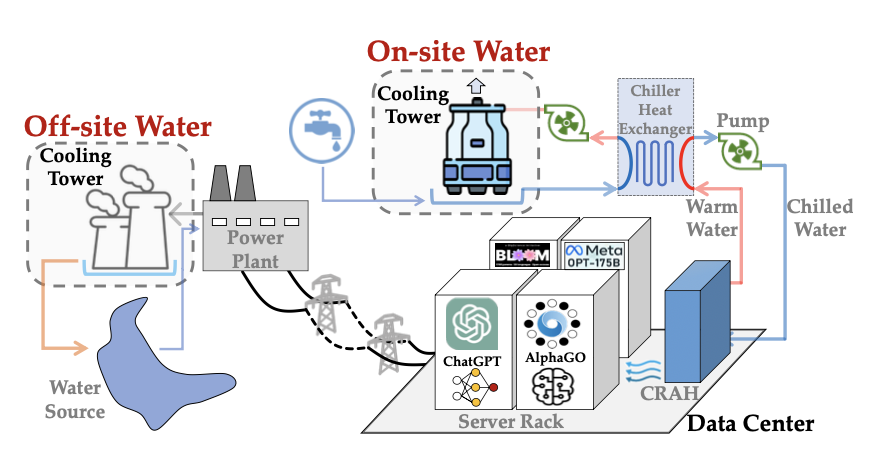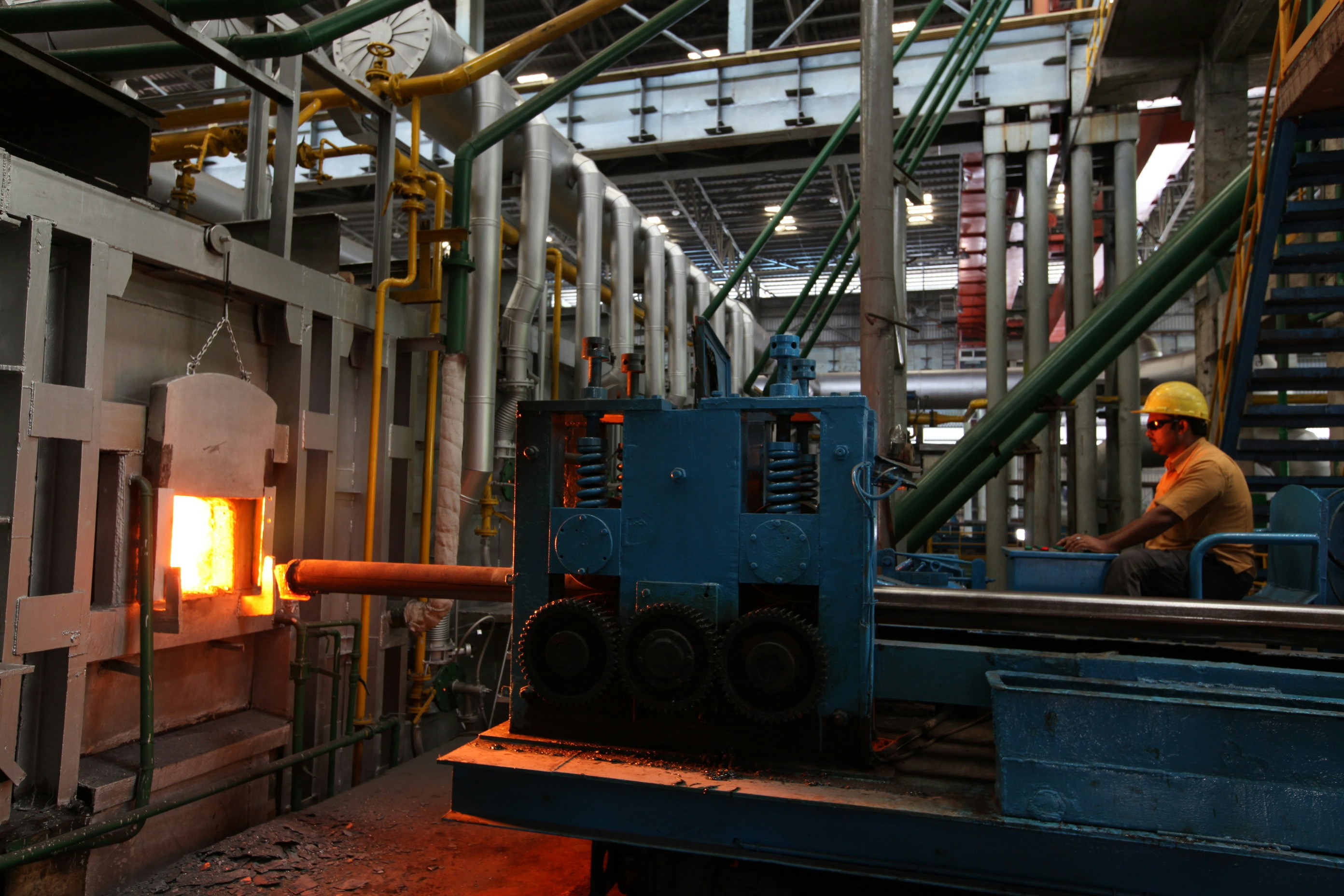The Lifecycle of AI is beyond just individual usage of generative AI models. It spans from the raw materials needed for the microchips and the buildings that host them, the training of models and how they learn human-understandable information, to the disposal of hardware and other materials.
Massive amounts of water and energy are used at each step of the life of AI, which can be differentiated through the scope of carbon emissions. Coined by the “Greenhouse Gas Protocol,” the scopes of emissions detail the different kinds of emissions a company creates in its own operations and in its wider deployment1.

Pengfei Li, Jianyi Yang, Mohammad A. Islam, Shaolei Ren, "Making AI Less “Thirsty”: Uncovering and Addressing the Secret Water Footprint of AI Models" (n.p.: n.p., 2025), 3, fig. 1.
For an AI or data center company, scope 1 refers to direct emissions from company-controlled sources, such as on-site electricity generators and heating/cooling systems; scope 2 describes the indirect emissions from purchased energy, including energy used from the power plants that data centers rely on; scope 3 includes other indirect emissions in the AI lifecycle, for example: electricity used to manufacture semiconductors or chips, as well as energy used to extract raw materials for manufacturing.
In this page, we will explain the different usage of water and energy at each step, and their scope of carbon emissions.
Resource Extraction
Scope 3 Emissions

Image by MiningWatch Portugal
The extraction of raw materials for AI includes those used to build the data center structure, such as limestone, clay, and sand for concrete, as well as iron for steel. Additionally, it involves the extraction of raw materials for the microchips AI runs on2, including aluminum, silicon, and copper. This process requires energy and water.
Equipment Manufacturing
Scope 3 Emissions

Image by Louis Reed
Equipment manufacturing for AI includes creating the chips that AI is run on for hardware, to the creation and building of data centers across the globe. The building of chips uses water for rinsing the different layers of semiconductor wafers that form the CPU and GPU chips (about 2.1-2.6 gallons for each microchip)2. All water used for rinsing must be purified to prevent damage to the chips and render them useless3.
Model Deployment
Scope 1 and 2 Emissions

Image by Focal Foto
AI model deployment is the process of using an AI model to carry out the task that it was trained for, whether that is generating text, images, or videos, replying in a simulation game, or beyond. However, model deployment does not mean that model training is not ongoing, and in its deployment the model can gain further insights for future training. Model deployment’s interaction with users requires a massive amount of water and energy to cool data centers, and to supply electricity for the data center servers to respond in a timely manner6.
Material Manufacturing
Scope 3 Emissions

Image by NIloy Tanvirul
Beyond the extraction of raw materials, the process of creating usable natural resources into malleable materials requires energy for production, and water to clean, shape and mold the materials2.
Model Training
Scope 1 and 2 Emissions

Image by Akela
Model training of AI is the process of providing data to an AI model that is meant to enable it to produce more accurate predictions. Each model has different levels of efficiency when training, which is affected by the hardware it uses such as computer chips and the region where it is being trained (cooler regions may require less energy to keep servers at appropriate temperatures). Models can be trained billions of times over a dataset until the best outcome is achieved. Model training happens at data centers, which use a massive amount of energy and water for their cooling systems4
Disposal
Scope 1 Emissions

Image by Maxim Shklyaev
Once AI is used, AI systems such as past chips, wasted extracted materials, unsuitable or unfiltered water, past data center computers, and more must be disposed of. The energy used for disposal must be taken into account. As AI evolves, environmental impact assessments of disposal is needed.
Resource Extraction
Scope 3 Emissions

Image by MiningWatch Portugal
The extraction of raw materials for AI includes those used to build the data center structure, such as limestone, clay, and sand for concrete, as well as iron for steel. Additionally, it involves the extraction of raw materials for the microchips AI runs on2, including aluminum, silicon, and copper. This process requires energy and water.
Material Manufacturing
Scope 3 Emissions

Image by NIloy Tanvirul
Beyond the extraction of raw materials, the process of creating usable natural resources into malleable materials requires energy for production, and water to clean, shape and mold the materials2.
Equipment Manufacturing
Scope 3 Emissions

Image by Louis Reed
Equipment manufacturing for AI includes creating the chips that AI is run on for hardware, to the creation and building of data centers across the globe. The building of chips uses water for rinsing the different layers of semiconductor wafers that form the CPU and GPU chips (about 2.1-2.6 gallons for each microchip)2. All water used for rinsing must be purified to prevent damage to the chips and render them useless3.
Model Training
Scope 1 and 2 Emissions

Image by Akela
Model training of AI is the process of providing data to an AI model that is meant to enable it to produce more accurate predictions. Each model has different levels of efficiency when training, which is affected by the hardware it uses such as computer chips and the region where it is being trained (cooler regions may require less energy to keep servers at appropriate temperatures). Models can be trained billions of times over a dataset until the best outcome is achieved. Model training happens at data centers, which use a massive amount of energy and water for their cooling systems4
Model Deployment
Scope 1 and 2 Emissions

Image by Focal Foto
AI model deployment is the process of using an AI model to carry out the task that it was trained for, whether that is generating text, images, or videos, replying in a simulation game, or beyond. However, model deployment does not mean that model training is not ongoing, and in its deployment the model can gain further insights for future training. Model deployment’s interaction with users requires a massive amount of water and energy to cool data centers, and to supply electricity for the data center servers to respond in a timely manner6.
Disposal
Scope 1 Emissions

Image by Maxim Shklyaev
Once AI is used, AI systems such as past chips, wasted extracted materials, unsuitable or unfiltered water, past data center computers, and more must be disposed of. The energy used for disposal must be taken into account. As AI evolves, environmental impact assessments of disposal is needed.

